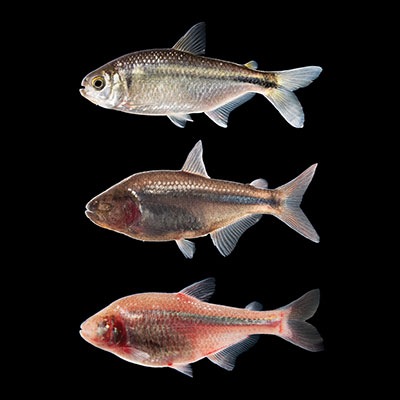Staff Writer
Purpose
The Institute for Creation Research (ICR) is testing an engineering- based model of rapid biological adaptation called continuous environmental tracking (CET).1 According to this model, all organisms actively track conditions within specific environments to perform adaptive self-adjustments through internal mechanisms. The purpose of this research is to demonstrate that organisms are the agents in control of adaptations that could not arise through random mutations or unguided genetic variation over artificial timescales. If we are correct, conventional hypotheses that attribute the exquisite fit of organisms to their environments through the agency of nature are unfounded.
Methods
The animal model is Astyanax mexicanus (Mexican tetra), a freshwater fish species with two morphotypes—eyed surface-dwelling fish (surface fish) with distinct pigmentation and eyeless cave-dwelling fish (cavefish) with minimal pigmentation. Within ICR’s new biology laboratory, we have exposed fish to treatments with (A) diurnal cycles of full-spectrum high-intensity light, (B) minimal light with different combinations of low oxygen and high CO2 (low pH), and (C) deionized water. Importantly, the responses of experimental fish to treatments are directly comparable to untreated stocks of surface fish and cavefish.
We have also sampled adult fish tissues (e.g., body, gill, brain) for applications in molecular biology to detect biochemical, neuronal, and genetic patterns of expression and regulation underlying adaptive responses to experimental treatments. And we are currently characterizing eye growth and degeneration during early stages of development in larval surface fish and cavefish.

Results
Preliminary results reveal:
- Cavefish increase the amount and distribution of melanin pigment across their body when exposed to artificial sunlight.
- Cavefish exhibit behavioral and physiological tolerance to low pH and low oxygen.
- Surface fish decrease pigmentation across their body and labor during respiration in low pH and low oxygen.
- Melanin pigmentation in surface fish is noticeably reduced by immersion in deionized water.
- Cavefish and surface fish respond to treatments within weeks of exposure.
- Experimental responses by cavefish and surface fish are not limited to multigenerational genetic inheritance.
- Degeneration of eye formation by cell death (apoptosis) is detectable through confocal laser scanning microscopy.
Overall, results indicate that cavefish are pre-acclimated to experimental conditions that simulate limestone cave environments (low pH, low oxygen, and total darkness), and surface fish undergo active self-adjustment when placed into simulated cave environments.
Impact
We are not surprised to find that animals are adaptive to specific conditions within contrasting environments. The CET model predicts a multisystem integration of molecular, biochemical, cellular, physiological, and behavioral adaptations across the whole organism. This model also predicts that multicellular organisms can modify the course of their development, epigenetic changes are heritable across multiple generations, and common traits will be observed among a diversity of organisms living in similar environments. And these predictions are testable.
Thus far, initial experimental results indicate that A. mexicanus may undergo relatively rapid transitions between surface and cave environments, suggesting that adaptive traits in these fish and other animals are reversible. Rapid and reversible adaptations are not explained by any Darwinian models of evolution. Yet, prior to formulation and testing of ICR’s innovative CET model, there had been no formal efforts by creation scientists to directly refute the mutation-selection paradigm through experimentation with live animals.
Accordingly, we have initiated a new direction in experimental science for ICR and creation science that sees every organism as a divinely engineered creation with adaptive capacity across multiple environmental conditions. Our research aims to confirm that life is thoughtfully and intentionally prepared by the infinite wisdom of our Creator, “in whose hand is the life of every living thing, and the breath of all mankind” (Job 12:10).
Reference
- For more information, visit ICR.org/CET.









